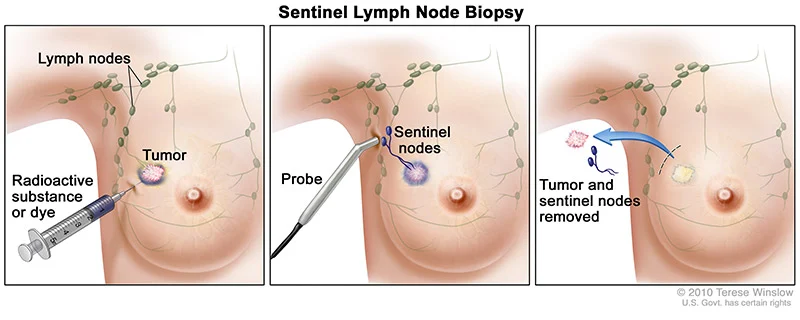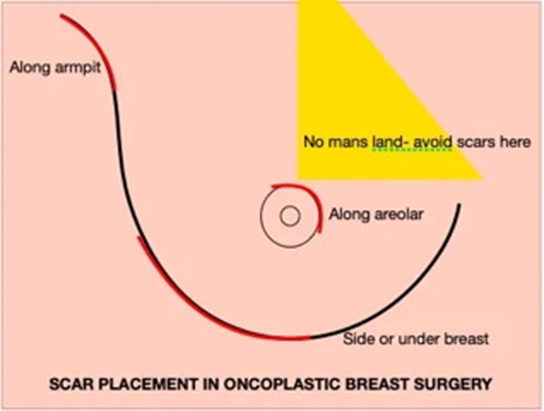Introduction:
Matthew T. Hueman, MD, FACS, FSSO, Breast Surgeon
Facing a breast cancer diagnosis can be overwhelming, but understanding the various surgical options available can empower you to make informed decisions that align with your health goals and body image.
In this blog, we will explore different types of breast cancer surgery. For most women with breast cancer, various surgical approaches can effectively treat the cancer while achieving a desirable cosmetic outcome. The type of surgery selected will depend on both your personal preferences and the medical requirements for effectively treating the cancer.
Most women with breast cancer have an equal choice between two therapies, each offering the same hope for a cure:
-
- Breast-conserving treatment (removing the cancer while preserving the breast, known as lumpectomy, followed by radiation therapy).
- Mastectomy (removing the entire breast) with or without breast reconstruction.
The choice between these two therapies is highly personal, and your trusted surgeon will help you make an informed decision that aligns with your goals and values.
Many women will also require additional therapies, including hormonal therapy (for 5 to 10 years after surgery) and radiation therapy. Some may also need systemic therapies to treat cancer in other parts of the body, such as chemotherapy or immunotherapy.
1. Lumpectomy:
Lumpectomy, or breast-conserving surgery, involves removing the tumor while preserving as much healthy breast tissue as possible. Most women are candidates for lumpectomy to treat breast cancer. This approach aims to cure the cancer while maintaining the natural appearance of the breast and minimizing the impact on its look (cosmesis). Following a lumpectomy, radiation therapy is often recommended to reduce the risk of cancer recurrence.
2. Mastectomy:
Mastectomy involves the complete removal of breast tissue and is recommended in cases where the tumor is large, located in multiple areas, or when radiation is contraindicated. Even if you qualify for lumpectomy, you may choose mastectomy.

Choosing mastectomy is a very personal decision. Your surgeon will help you determine which mastectomy approach is best for you and your treatment. There are several types of mastectomies:
- Total (simple) mastectomy: The surgeon removes all breast tissue, including the nipple, areola, and most overlying skin.
- Skin-sparing mastectomy: The surgeon removes all breast tissue, including cancer, while preserving most of the breast skin to facilitate reconstruction, contributing to a more natural-looking outcome. The nipple-areola complex is removed, but a reconstruction surgeon can create a new nipple-areola during a later procedure.
- Nipple-sparing mastectomy: All breast tissue, including ducts leading to the nipple and areola, is removed while preserving the skin of the breast, nipple, and areola. The tissue around the nipple is examined by a pathologist to ensure no cancer cells are present. If cancer is detected, the procedure may convert to a skin-sparing mastectomy.
- Modified radical mastectomy: The entire breast, including the nipple and most overlying skin, is removed, along with most lymph nodes under the arm (axillary lymph node dissection). This approach is generally reserved for aggressive or advanced breast cancers suspected to have spread to the axillary lymph nodes. In rare cases, radical mastectomy may be required, which involves removing all chest muscles.
3. Breast Reconstruction:
For those undergoing mastectomy, breast reconstruction offers a way to restore the breast’s appearance. Reconstruction can be performed using implants or your own tissue (e.g., from the abdomen or back). You will work closely with a reconstructive surgeon to make personalized choices aligned with your values and preferences.
- Implant reconstruction: This typically involves at least two surgeries. The first surgery places a tissue expander, gradually filled during office visits until the desired size is reached. The second surgery replaces the expander with a breast implant. Additional procedures may reconstruct the nipple-areola area or improve overall appearance.
- Tissue flap reconstruction: This method uses tissue from other body parts, like the abdomen or back, to rebuild the breast. Tissue flaps can look and feel more natural than implants and will change with your body. However, flap procedures usually require more extensive surgery and longer recovery time, leaving scars at both the donor site and the reconstructed breast. Potential complications include abdominal bulging or muscle weakness.
4. Axillary Lymph Node Surgery:
Most women with breast cancer undergo surgery on the lymph nodes under their arm (axillary lymph nodes).
For most women with invasive breast cancer, a sentinel lymph node biopsy is performed, removing 2 or 3 lymph nodes to assess whether cancer has spread, which helps inform prognosis. Women with more advanced or aggressive breast cancer may require an axillary lymph node dissection, which removes 10 to 20 or more lymph nodes.
A sentinel lymph node biopsy involves injecting a radioactive dye to identify the main draining lymph nodes. If no cancer cells are found in the sentinel nodes, the surgery may conclude there. If cancer is detected in multiple nodes, additional therapies such as chemotherapy or radiation may be considered.

5. Oncoplastic Surgery:
Oncoplastic surgery combines cancer removal with plastic surgery techniques to achieve optimal cosmetic results. Many breast surgeons use this approach during lumpectomy procedures when feasible, allowing for hidden scars and reshaping of the breast to maintain symmetry and aesthetic balance while effectively treating the cancer.
For example, breast cancer can often be approached by placing the surgical scar in various locations to conceal it, making the scars less visible.

Navigating breast cancer surgery is a deeply personal journey that requires careful consideration of both medical options and individual values. Whether you opt for a lumpectomy, mastectomy, or reconstruction, it’s essential to prioritize both your health and your body image throughout the process. Engaging in open discussions with your healthcare team will empower you to make informed choices that align with your goals.


















